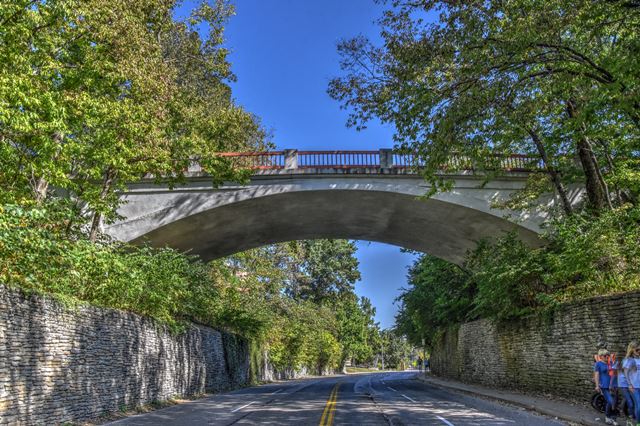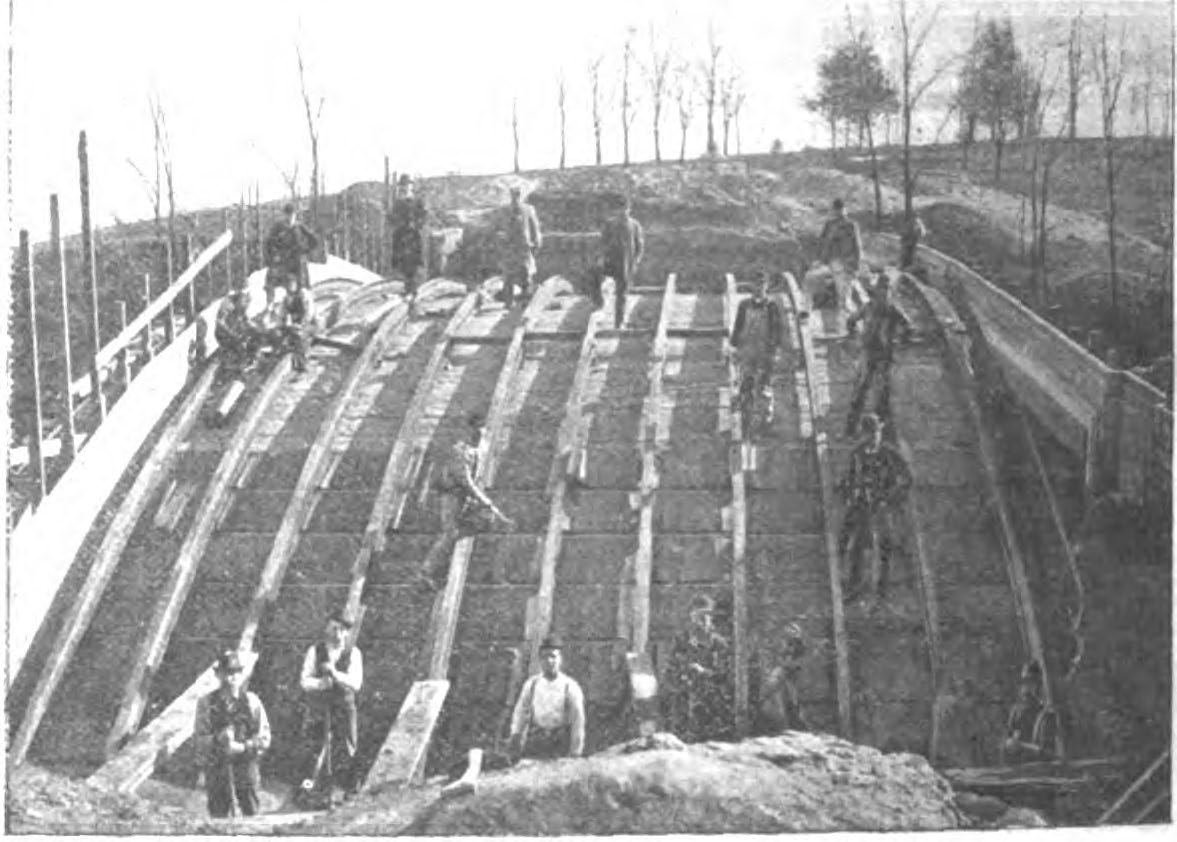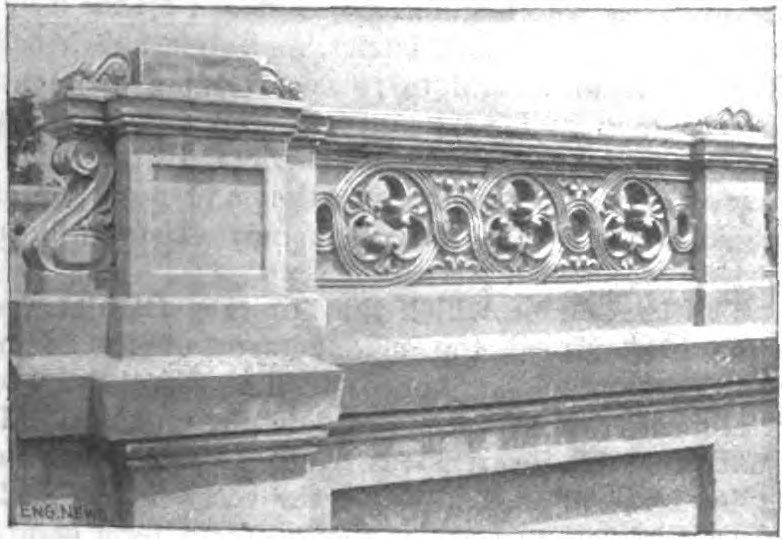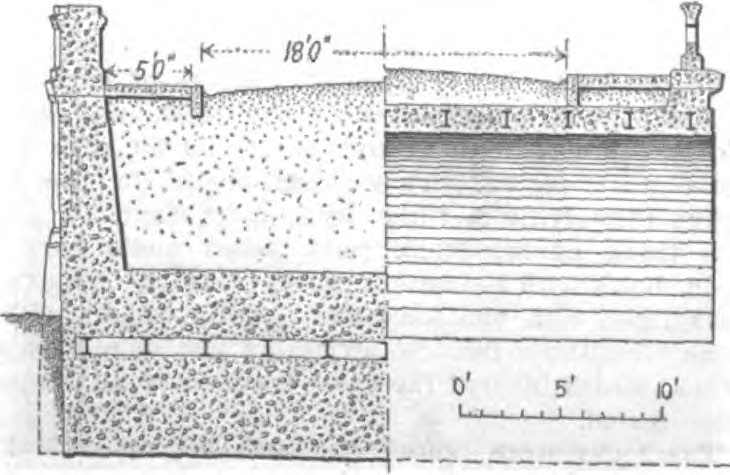We Recommend:
Bach Steel - Experts at historic truss bridge restoration.
BridgeHunter.com Phase 1 is released to the public! - Visit Now
Eden Park Bridge
Cliff Drive Bridge

Primary Photographer(s): Nathan Holth
Bridge Documented: September 22, 2019
Cincinnati: Hamilton County, Ohio: United States
1894 By Builder/Contractor: Melan Arch Construction Company of New York, New York and Engineer/Design: Frederick von Emperger of New York, New York
2006
70.0 Feet (21.3 Meters)
117.0 Feet (35.7 Meters)
18 Feet (5.49 Meters)
1 Main Span(s)
3160726

View Information About HSR Ratings
Bridge Documentation
Among the oldest surviving concrete bridges in America, this is the first and oldest concrete bridge in Ohio. It is a rare Melan type arch bridge, designed and built by the American representatives of the patented Melan technology at the time. The beautiful original railings on this bridge were replaced in 1949, but otherwise the bridge retains good integrity.
View Archived National Bridge Inventory Report - Has Additional Details and Evaluation
View Historical Article About This Bridge
View Historical Biography of Edwin Thacher
View Old Historic Bridge Inventory Sheet For This Bridge
Above: Historical photo of newly completed bridge.
Above: Historical photo showing bridge construction, with the steel reinforcing beams visible in place on the bridge.
Above: Detail of original railing.
Above: Cross section drawing of bridge from historical article on bridge.
Information and Findings From Ohio's Historic Bridge InventorySetting/Context The bridge carries 2 lane of traffic and sidewalks over a 2-lane drive in Cincinnati's Eden Park. The bridge is north of the art museum and west of an overlook of the Ohio River. To the west is a handsome brick-faced Victorian-style standpipe, part of the city's water system. Physical Description The 1 span, 117'-long arch is a Melan arch. It is plainly finished with paneled spandrel walls. It has metal tubular panel railings with concrete posts. Integrity Replacement railings (1949). Rehabilitation (2005/06). Patching and coating arch, painted steel railings. Summary of Significance The Cliff Drive arch is a highly significant example of its type/design and believed to be the oldest concrete arch in Ohio, although it is a Melan arch, i.e., it has steel beams embedded in the arch, and is as much in function a steel arch as a concrete one. Melan arches were introduced during the early period of development of reinforced-concrete technology and were built in the U.S. from the mid 1890s to early 1910s. Although eventually surpassed by the use of the Ransome-system of twisted, deformed reinforcing bars, they are considered significant in the evolution of the technology. The bridge was designed by Fritz Von Emperger of the Melan Arch Construction Co., the leading American promoter of the technology, which was imported from Europe. The bridge was sensitively rehabilitated in 2006. The eligible recommendation of the prior inventory remains appropriate. "Closed spandrel arch bridges are the most basic of reinforced concrete bridge types. Closed spandrel means that the area between the deck and the arch ring was filled in. The spandrel wall actually serves as a retaining wall in the bridge, holding the fill material. Live loads are borne by the fill material and by the spandrel walls. The arch may be constructed either as a single structural element (barrel) or in separate parallel longitudinal ribs. The barrel arch design has some structural and visual similarities to stone arch bridges. The barrel arch is also sometimes faced with brick or stone, making it appear similar to a masonry arch bridge. This type of bridge is suitable for short span lengths. Closed spandrel concrete arches predate open spandrels, as the closed spandrel type harkens back to the stone arches that the earliest forms imitated. This type was not built for long as engineers realized that significant material could be saved and a reduction in weight could be achieved by eliminating the filled section. Hence, open spandrels were born. Filled spandrel concrete arches date primarily from the earliest decades of reinforced concrete (1890s through 1920s). They are not as common as many of the standardized bridge types built during this same era, such as concrete slabs and girders. They are significant because they are not common and represent the evolution of concrete technology. To be considered significant, filled spandrel arches should have integrity, through the retention of their character-defining features: arch ring, barrel, spandrel wall, railing or parapet, end posts, piers and/or abutments and wingwalls." [From: A Context for Common Historic Bridge Types by Parsons Brinckerhoff, October 2005] Justification The bridge is a rare type with an exceptional level of significance. It is among the most significant Melan arches in the nation. Bridge Considered Historic By Survey: Yes |
This bridge is tagged with the following special condition(s): Melan
![]()
Photo Galleries and Videos: Eden Park Bridge
Bridge Photo-Documentation
Original / Full Size PhotosA collection of overview and detail photos. This gallery offers photos in the highest available resolution and file size in a touch-friendly popup viewer.
Alternatively, Browse Without Using Viewer
![]()
Bridge Photo-Documentation
Mobile Optimized PhotosA collection of overview and detail photos. This gallery features data-friendly, fast-loading photos in a touch-friendly popup viewer.
Alternatively, Browse Without Using Viewer
![]()
Maps and Links: Eden Park Bridge
Coordinates (Latitude, Longitude):
Search For Additional Bridge Listings:
Bridgehunter.com: View listed bridges within 0.5 miles (0.8 kilometers) of this bridge.
Bridgehunter.com: View listed bridges within 10 miles (16 kilometers) of this bridge.
Additional Maps:
Google Streetview (If Available)
GeoHack (Additional Links and Coordinates)
Apple Maps (Via DuckDuckGo Search)
Apple Maps (Apple devices only)
Android: Open Location In Your Map or GPS App
Flickr Gallery (Find Nearby Photos)
Wikimedia Commons (Find Nearby Photos)
Directions Via Sygic For Android
Directions Via Sygic For iOS and Android Dolphin Browser
USGS National Map (United States Only)
Historical USGS Topo Maps (United States Only)
Historic Aerials (United States Only)
CalTopo Maps (United States Only)





